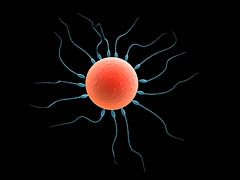It is now more
than 34 years since the world’s first birth from IVF, a technique that mimics
the process of human fertilization in the laboratory. Over this period of time,
countless couples all over the world have benefited from IVF, the majority of
whom would never have been able to have a child without it. While it is now
readily and widely available, a high degree of knowledge, skill and attention
to detail by the doctor and the laboratory is required before consistently high
pregnancy rates can be achieved.
Couples are
recommended to undergo IVF if they face one of the following problems:
·
tubal factors (tubal blockage or dysfunction)
·
endometriosis
·
male factor infertility
·
immunological infertility (anti-sperm
antibodies)
·
repeated unsuccessful IUI
·
unexplained infertility
The wife
undergoes controlled ovarian hyperstimulation (COH), either with long protocol
or short protocol, depending on her condition. A hCG injection is given to
mature the eggs when the leading follicles have reached 18mm. 34 hours later,
oocyte pick up (OPU) or egg collection, will be done. OPU is the process of
aspirating the eggs through the vagina.
The OPU is a
minor procedure performed under sedation or general anaesthesia as a daycase.
The OPU is performed in a specialized IVF Operating Theatre (OT). A very fine
needle is inserted through the vagina under transvaginal ultrasound guidance.
The needle punctures through the vaginal wall and into the ovaries to harvest
the eggs. The eggs which are now in a test tube are handed over to the
embryologist for processing. The laboratory is located next to the IVF OT to
ensure minimal exposure to the external environment. The entire procedure takes
only about 15 minutes and she will wake up immediately after that. She will be
allowed to go home after 2 hours.
After the semen
is produced by the husband, the laboratory technician or embryologist will
process the semen by removing the seminal plasma, debris, residual cells, dead
and sluggish sperm. This is done by a series of steps including adding sperm
wash media and centrifuging. The final solution with live and motile sperm will
be inseminated to the culture media containing eggs to allow fertilisation to
occur. The mixture will be cultured in the Carbon Dioxide incubator.
The eggs are
fertilized and are now called embryos. The embryos are cultured for between 2
to 5 days, depending on the number of fertilized eggs available. Embryo
transfer (ET) is a minor procedure where the fertilized eggs are transferred
into the womb through a very fine flexible catheter. the number of embryos to
be transferred depends on several factors such as the age of the woman, the
quality of the embryos and the wishes of the couple. Doctors will usually
transfer the optimum number of embryos to achieve the best results with the
least risk of multiple pregnancies. Good embryos that are not transferred will
be frozen for use in the future.
3 day old embryos
Embryo transfer
(ET) requires no sedation or anaesthesia and it is similar to that of IUI.
However, ET requires ultrasound guidance. A speculum is inserted into vagina to
hold it open. Ultrasound guidance enables the doctor to visualise the insertion
of ET catheter into the uterus so that can ensure that the embryos will be
place near the fundus and minimise the trauma to the endometrium. The whole procedure
takes only 5 minutes to complete.
After ET, the
wife will require some luteal support such as vaginal pessary or injection. She
has to take extra care such as:
·
rest more and avoid excessive physical
activities. Bed rest is not necessary.
·
remember to take progesterone medication daily
·
drink plenty of water
·
not take any medication without doctor
consultation
·
avoid sexual intercourse for at least three
months
A blood
pregnancy test will be carried out approximately 2 weeks after the transfer. If
she is pregnant, she will be required to continue the progesterone support for
another month or so. If unfortunately she is not pregnant, the doctor will
review the entire treatment with her and discuss her options if she would like
to try again. If she has excess embryos frozen, she may undergo a Frozen Embryo
Transfer (FET) about 2 months later.
Since the first
IVF-ET carried out in 1978, over four million babies have been born using this
method. It is an effective treatment for almost all causes of infertility.
There is no increase in the risk of abnormality of the baby compared to a
natural conception.
6 week old twin IVF pregnancy
9 week old IVF pregnancy
12 week old IVF foetus
32 week old IVF baby
VF costs
between RM 12,000 to RM20,000 per cycle in Malaysia and there is no 100%
guarantee you will succeed on your first try. Due to the high cost, it is
imperative for couples to do a thorough research in finding the right fertility
specialist with vast experience and high success rates.







No comments:
Post a Comment